Dear Aspirants, Our IBPS Guide team is providing new series of Reasoning Questions for IBPS RRB Clerk/EPFO Assistant/LIC ADO Prelims Reasoning Ability Questions 2019 Prelims 2019 so the aspirants can practice it on a daily basis. These questions are framed by our skilled experts after understanding your needs thoroughly. Aspirants can practice these new series questions daily to familiarize with the exact exam pattern and make your preparation effective.
Check here for IBPS RRB Clerk Prelims Mock Test 2019
Check here for EPFO Assistant Prelims Mock Test 2019
Click Here to Subscribe Crack High Level Puzzles & Seating Arrangement Questions PDF 2019 Plan
[WpProQuiz 6767]
Directions (1-5): Study the following information carefully and answer the questions given below.
Seven persons A, B, C, D, E, F and G were born on January, March, April, May, June, July, October and November but not necessarily in the same order. There was a month where no one is born.
G was not born in April. C was born in a month which has 30 days. Two persons were born between C and F. No person was born in a month just before C. E was born in a month just before D. Three persons were born between E and B, who is born in one of the months before E. A was not born in a month just before F. F is not born in January.
1) In which of the following month does F born?
a) May
b) November
c) March
d) October
e) None of these
2) Which of the following statement is correct?
a) A was born on June
b) G was born on November
c) B was born just after A
d) C was born on July
e) None of these
3) Who among the following is born on October?
a) B
b) F
c) A
d) D
e) None of these
4) How many persons were born between G and D?
a) One
b) Two
c) Three
d) Four
e) None of these
5) Four of the five in the following are similar in such a way to form a group, which one of the following doesn’t belongs to the group?
a) D
b) E
c) G
d) D
e) F
Directions (6-10): Study the following information carefully and answer the questions given below.
Eight persons S, K, J, H, E, A, R and T are sitting in a linear row facing south but not necessarily in the same order.
Only two people sit between E and T. Only one person sits between S and J. T is not an immediate neighbour of S. Only three people sit between J and R. K sits third to the left of E. H is not an immediate neighbour of R. S sits at one of the extreme ends of the row.
6) Who sits second to the left of A?
a) S
b) K
c) H
d) R
e) None of these
7) Who among the following are immediate neighbours of the persons who are sitting at extreme ends of the row?
a) K, A
b) R, K
c) E, A
d) E, R
e) None of these
8) Who sits third to the left of J?
a) None
b) A
c) R
d) T
e) None of these
9) If all the persons are made to sit according to the alphabetical order from left end to right end of the row, then how many persons remain unchanged from his original position?
a) One
b) Two
c) Three
d) More than Three
e) None
10) What is the position of E with respect to R?
a) Third to the right
b) Second to the left
c) Second to the right
d) Immediate right
e) None of these
Answers :
Directions 1-5):
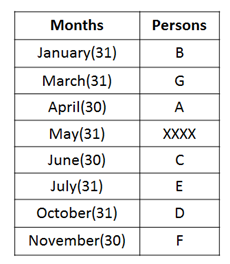
- C was born in a month which has 30 days.
- No person was born in a month just before C.
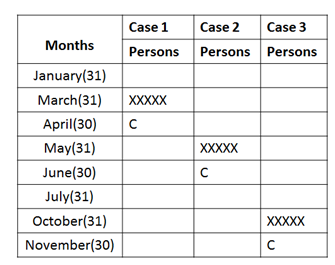
- Two persons were born between C and F.
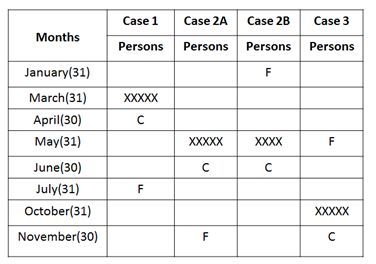
- E was born in a month just before D.
- Three persons were born between E and B, who is born in one of the months before E. We cannot fix the position of B in case 1. So case1 is eliminated.
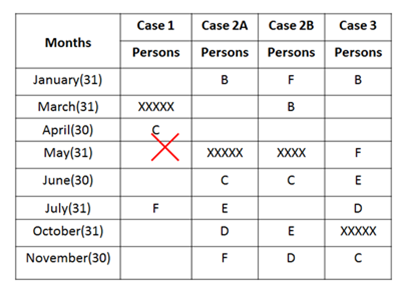
- G was not born in April. From this statement we can place A and G in all the cases.
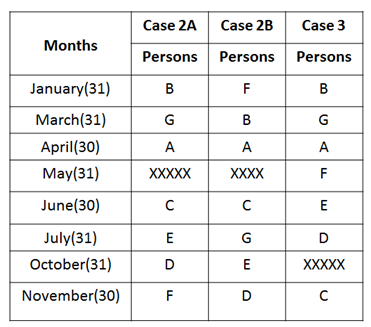
- A was not born in a month just before F. Case 3 is not satisfied. So this case is eliminated
- F was not born in January. Case 2A is not satisfied. So this case is also eliminated and finally case 2B is the final arrangement.
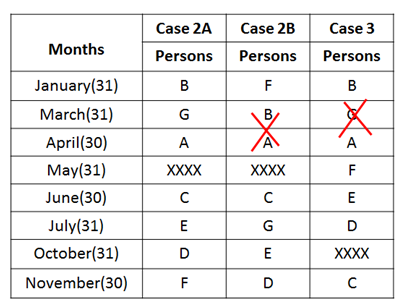
1) Answer: B
2) Answer: E
3) Answer: D
4) Answer: C
5) Answer: E
Direction (6-10):

- S sits one of the extreme ends of the row.

- Only one person sits between S and J.
- Only three people sit between J and R.

- Only two people sit between E and T.
- K sits third to the left of E.
- T is not an immediate neighbour of S.
- From these above statements we cannot fix the position of E, K and T in case 2 .

- H is not an immediate neighbour of R.

6) Answer: C
7) Answer: B
8) Answer: A
9) Answer: A
10) Answer: B





